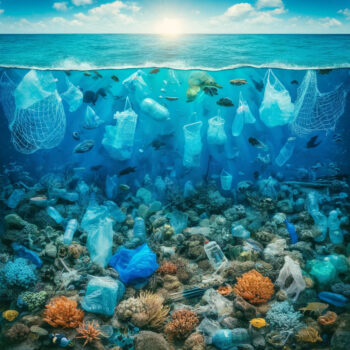April 10th, 2024
Staff Writer for Wake Up World
In a groundbreaking study, our ocean floors’ vast, uncharted territories were revealed as the ultimate reservoirs of plastic pollution. This study challenged our understanding of oceanic waste management and its impact on marine ecosystems. With new research from CSIRO, Australia’s national science agency, and the University of Toronto, we are now closer to comprehending the magnitude of this issue and the urgent need for action.
The Alarming Reality of Ocean Floor Pollution
The Surprising Scale of the Crisis
“Every minute, a garbage truck’s worth of plastic enters the ocean,” begins a startling revelation from the collaborative research by CSIRO and the University of Toronto. This research brings to light the first estimate of the colossal amount of plastic pollution that finds its way to the ocean floor, which could be as high as 11 million tonnes. With the use of plastic expected to double by 2040, understanding the journey of this pollution becomes not just a matter of scientific inquiry but a dire necessity for marine conservation efforts.
A Deep Dive into the Findings
Dr Denise Hardesty, a Senior Research Scientist with CSIRO, shared, “We discovered that the ocean floor has become a resting place, or reservoir, for most plastic pollution, with between 3 to 11 million tonnes of plastic estimated to be sinking to the ocean floor.” This research not only quantifies the issue but also highlights the longevity of plastic waste, which accumulates and gradually breaks down into smaller pieces, eventually mixing with ocean sediment.
The Deep Ocean: A Permanent Sink for Plastics
Beyond Surface Pollution
Ms Alice Zhu, a PhD from the University of Toronto who led the study, pointed out a critical comparison: the estimate of plastic pollution on the ocean floor could be up to 100 times greater than the amount of plastic floating on the ocean’s surface. This emphasizes the gravity of the issue, as the ocean surface has often been the primary focus of pollution studies and clean-up efforts.
“The ocean surface is a temporary resting place of plastic, so it is expected that if we can stop plastic entering our oceans, the amount would be reduced,” Ms. Zhu noted. However, her research found that plastic continues to find its way into the deep ocean, making it a permanent reservoir for marine plastic pollution.
Insights from Predictive Models
The study employed two predictive models based on data from remote-operated vehicles (ROVs) and bottom trawls to estimate the distribution of plastic on the ocean floor. Findings reveal that plastic mass clusters around continents, with approximately half of the predicted plastic mass residing above 200 m depth. Surprisingly, inland and coastal seas, despite their smaller surface area compared to the open ocean, are predicted to hold as much plastic mass as the rest of the ocean floor.
Moving Forward: Towards a Solution
Filling the Knowledge Gap
“These findings help to fill a longstanding knowledge gap on the behaviour of plastic in the marine environment,” stated Ms. Zhu. By understanding the forces driving the transport and accumulation of plastic in the deep ocean, we can better inform source reduction and environmental remediation efforts. This is crucial for mitigating the risks that plastic pollution poses to marine life.
A Call to Action
This research forms part of CSIRO’s Ending Plastic Waste Mission, which aims to revolutionize how we produce, use, recycle, and dispose of plastic. It’s a clarion call for collective action, urging us to reconsider our relationship with plastic and its lasting impact on the planet’s most remote and unexplored habitats.
As this study’s findings circulate, they serve as a poignant reminder of our interconnectedness with the natural world and the urgent need for sustainable practices to protect our oceans. The path to a cleaner, healthier marine environment is complex, but with informed action and global cooperation, it is within reach.
Practical Steps to Combat Ocean Floor Plastic Pollution
In light of the sobering revelations regarding the scale of plastic pollution settling on the ocean floor, it becomes imperative for each of us to take actionable steps to mitigate this crisis. Here are practical ways individuals and communities can contribute to reducing the influx of plastic into our oceans and safeguarding marine ecosystems.
For Individuals and Households:
- Reduce Plastic Usage: Begin by minimizing your reliance on single-use plastics. Opt for reusable alternatives such as water bottles, shopping bags, and straws. Every small change contributes to a larger impact.
- Proper Waste Management: Ensure that plastic waste is correctly disposed of and, where possible, recycled. Participate in local recycling programs and educate yourself on which plastics are recyclable in your area.
- Support Eco-Friendly Brands: Purchase products from companies that prioritize sustainable packaging and are committed to reducing plastic waste. Your spending power can drive positive change in corporate practices.
- Beach Clean-Ups: Participate in or organize local beach clean-ups. This direct action not only removes waste from marine environments but also raises awareness about the severity of ocean pollution.
For Communities:
- Educational Programs: Implement educational initiatives in schools and community centers to teach the importance of reducing plastic waste and proper recycling practices.
- Infrastructure for Recycling: Develop and enhance community recycling facilities to make it easier for residents to recycle. Properly managed waste reduces the likelihood of plastics entering waterways.
- Policy Advocacy: Advocate for local policies that limit single-use plastics and encourage businesses to adopt sustainable practices. Community support for environmental regulations can influence policymakers.
Final Thoughts
The journey to significantly reduce the plastic ending up on ocean floors is daunting but necessary. It requires concerted efforts from individuals, communities, and governments worldwide. By adopting sustainable practices, advocating for change, and supporting research and innovation, we can protect our oceans for future generations. Let’s take these steps together, embracing our responsibility to heal and preserve our planet’s magnificent marine ecosystems.
Journal Reference:
- Xia Zhu, Chelsea M. Rochman, Britta Denise Hardesty, Chris Wilcox. Plastics in the deep sea – A global estimate of the ocean floor reservoir. Deep Sea Research Part I: Oceanographic Research Papers, 2024; 206: 104266 DOI: 10.1016/j.dsr.2024.104266
About the author:
John Patterson is an avid writer and researcher who delves into the latest scientific research. With an insatiable curiosity, he translates complex concepts into accessible narratives, allowing readers to embark on a journey of discovery. John bridges the gap between experts and the public through his work, igniting curiosity and inspiring meaningful conversations about scientific breakthroughs.
[pro_ad_display_adzone id=”110027″]







